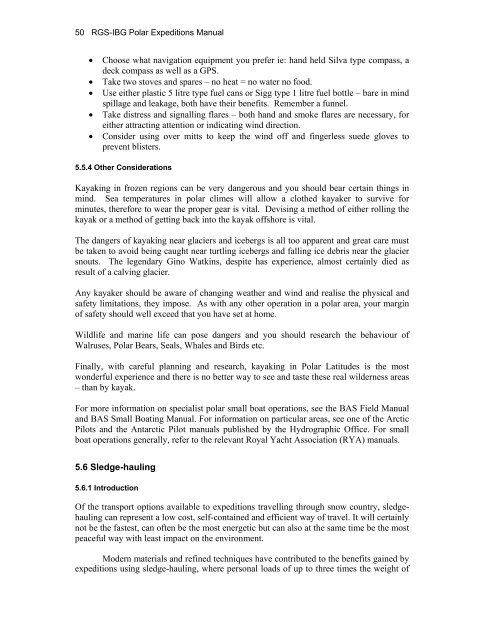Edited by Rachel Duncan 4th Edition ISBN 0-907649-91-2 London ...
Edited by Rachel Duncan 4th Edition ISBN 0-907649-91-2 London ...
Edited by Rachel Duncan 4th Edition ISBN 0-907649-91-2 London ...
You also want an ePaper? Increase the reach of your titles
YUMPU automatically turns print PDFs into web optimized ePapers that Google loves.
50 RGS-IBG Polar Expeditions Manual<br />
• Choose what navigation equipment you prefer ie: hand held Silva type compass, a<br />
deck compass as well as a GPS.<br />
• Take two stoves and spares – no heat = no water no food.<br />
• Use either plastic 5 litre type fuel cans or Sigg type 1 litre fuel bottle – bare in mind<br />
spillage and leakage, both have their benefits. Remember a funnel.<br />
• Take distress and signalling flares – both hand and smoke flares are necessary, for<br />
either attracting attention or indicating wind direction.<br />
• Consider using over mitts to keep the wind off and fingerless suede gloves to<br />
prevent blisters.<br />
5.5.4 Other Considerations<br />
Kayaking in frozen regions can be very dangerous and you should bear certain things in<br />
mind. Sea temperatures in polar climes will allow a clothed kayaker to survive for<br />
minutes, therefore to wear the proper gear is vital. Devising a method of either rolling the<br />
kayak or a method of getting back into the kayak offshore is vital.<br />
The dangers of kayaking near glaciers and icebergs is all too apparent and great care must<br />
be taken to avoid being caught near turtling icebergs and falling ice debris near the glacier<br />
snouts. The legendary Gino Watkins, despite has experience, almost certainly died as<br />
result of a calving glacier.<br />
Any kayaker should be aware of changing weather and wind and realise the physical and<br />
safety limitations, they impose. As with any other operation in a polar area, your margin<br />
of safety should well exceed that you have set at home.<br />
Wildlife and marine life can pose dangers and you should research the behaviour of<br />
Walruses, Polar Bears, Seals, Whales and Birds etc.<br />
Finally, with careful planning and research, kayaking in Polar Latitudes is the most<br />
wonderful experience and there is no better way to see and taste these real wilderness areas<br />
– than <strong>by</strong> kayak.<br />
For more information on specialist polar small boat operations, see the BAS Field Manual<br />
and BAS Small Boating Manual. For information on particular areas, see one of the Arctic<br />
Pilots and the Antarctic Pilot manuals published <strong>by</strong> the Hydrographic Office. For small<br />
boat operations generally, refer to the relevant Royal Yacht Association (RYA) manuals.<br />
5.6 Sledge-hauling<br />
5.6.1 Introduction<br />
Of the transport options available to expeditions travelling through snow country, sledgehauling<br />
can represent a low cost, self-contained and efficient way of travel. It will certainly<br />
not be the fastest, can often be the most energetic but can also at the same time be the most<br />
peaceful way with least impact on the environment.<br />
Modern materials and refined techniques have contributed to the benefits gained <strong>by</strong><br />
expeditions using sledge-hauling, where personal loads of up to three times the weight of

















